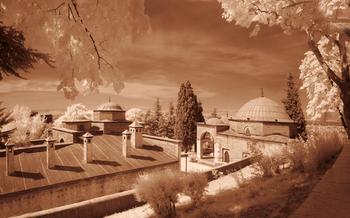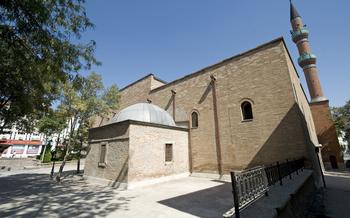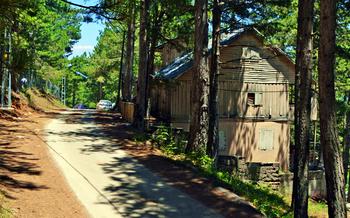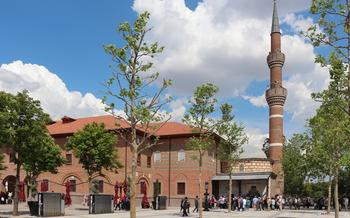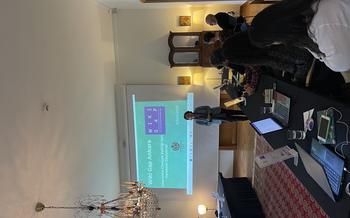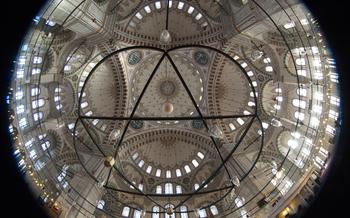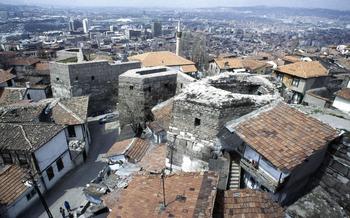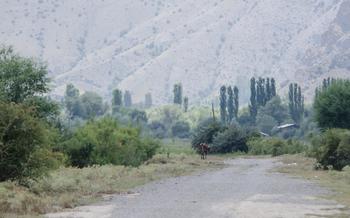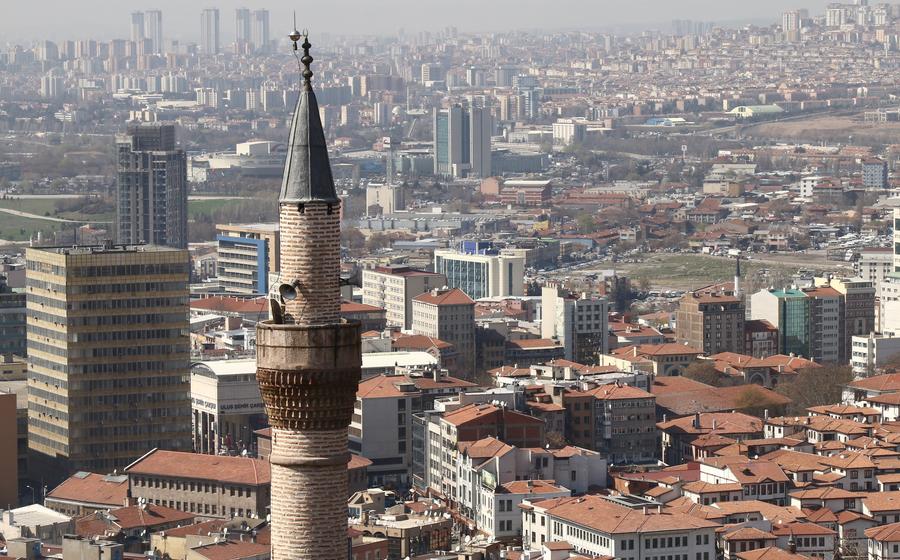
Abidinpaşa Mosque
- Historical Significance
- Architectural Marvel
- Religious Symbol
- Cultural Heritage
- Prayer Hall
- Courtyard:
- Minaret
- Dome
- Prayer Times
- Dress Code
- Visiting Hours
- Photography
- Accessibility
- Nearby Attractions: Exploring Ankara's Treasures
- Insider Tip:
Historical Significance
The Abidinpaşa Mosque stands as a testament to the rich history and cultural significance of Ankara. Constructed in the 15th century during the reign of Sultan Mehmed II, the mosque is a remarkable example of Ottoman architectural prowess, embodying the grandeur and artistry that characterized this period. Its strategic location in the heart of Ankara, near the historical Ulus district, further underscores its importance as a religious and cultural landmark in the city. The mosque has served as a center of worship and community gathering for centuries, playing a pivotal role in the spiritual and social fabric of Ankara's Muslim community.
Architectural Marvel
The Abidinpaşa Mosque stands as a testament to the grandeur and artistry of Ottoman architecture. Its striking silhouette is defined by a series of graceful domes, each adorned with intricate tilework that shimmers in the sunlight. Four slender minarets rise from the corners of the mosque, their elegant spires reaching towards the heavens. The mosque's courtyard is a tranquil oasis, featuring a central fountain surrounded by lush gardens and shaded seating areas.
The mosque's interior is equally impressive. The prayer hall is a vast and awe-inspiring space, supported by a forest of slender columns and crowned by a magnificent dome. The mihrab, the niche indicating the direction of prayer, is adorned with intricate carvings and colorful tiles. The minbar, the pulpit from which the imam delivers sermons, is a masterpiece of craftsmanship, featuring intricate woodwork and inlaid mother-of-pearl.
The mosque's walls are adorned with exquisite tilework, featuring vibrant geometric patterns and floral motifs. The calligraphy, which adorns the mihrab and other parts of the mosque, is a testament to the skill and artistry of Ottoman calligraphers. The overall effect of the mosque's architecture is one of grandeur, harmony, and spiritual upliftment.
Religious Symbol
The Abidinpaşa Mosque stands as a radiant symbol of Islamic faith in Ankara, attracting worshippers and visitors from across the city and beyond. As one of the most prominent mosques in the city, it holds a profound significance in the religious landscape of Ankara, serving as a spiritual and communal hub for the Muslim community.
The mosque's majestic presence commands attention, embodying the city's deep-rooted Islamic heritage. Its towering minarets pierce the sky, beckoning the faithful to prayer, while its intricate tilework and calligraphy adorn its façade, whispering tales of devotion and artistry.
Within its hallowed walls, the mosque exudes an atmosphere of spirituality and tranquility, inviting worshippers to immerse themselves in prayer and contemplation. The rhythmic chants of the imam reverberate through the vast prayer hall, uniting the congregation in a shared spiritual experience.
Cultural Heritage
The Abidinpaşa Mosque stands as a testament to the rich cultural heritage of Ankara and Turkey. Its design and architecture are deeply rooted in Turkish art and history, showcasing the country's unique blend of Islamic and Byzantine influences. The mosque's intricate tilework, calligraphy, and decorative elements reflect the artistic traditions of the Ottoman Empire, while its overall design embodies the grandeur and majesty of Islamic architecture.
Beyond its physical structure, the mosque also serves as a cultural hub, hosting various events and activities that celebrate Turkish culture and heritage. These events may include religious festivals, cultural exhibitions, and educational programs, providing visitors with an opportunity to immerse themselves in the vibrant tapestry of Turkish culture.
The mosque's connection to Turkish history is particularly evident in its role as a gathering place for the community. Throughout history, the mosque has served as a venue for social and religious gatherings, fostering a sense of unity and belonging among the local Muslim community. Its courtyard and prayer hall have witnessed countless weddings, funerals, and other significant life events, solidifying the mosque's position as an integral part of the city's cultural fabric.
Prayer Hall
The heart of the Abidinpaşa Mosque lies in its awe-inspiring prayer hall, a sanctuary of devotion and tranquility. Step inside, and you'll be captivated by its sheer size and capacity, allowing hundreds of worshippers to gather in unison. The hall's design is a testament to meticulous craftsmanship, with intricate tilework adorning the walls, creating a mesmerizing tapestry of patterns and colors.
The mihrab, a sacred niche indicating the direction of Mecca, stands as a focal point, its intricate carvings and delicate calligraphy a testament to the mosque's artistic heritage. Beside it, the minbar, an elevated pulpit, commands attention, its ornate design echoing the overall grandeur of the prayer hall.
As the call to prayer resonates through the hall, worshippers gather, their voices harmonizing in a melodious symphony of devotion. The air is charged with a palpable sense of spirituality, as prayers ascend towards the heavens, uniting the community in a sacred bond.
Courtyard:
The Abidinpaşa Mosque's courtyard serves as a vital gathering space for religious and social activities. Its spacious layout, adorned with meticulously arranged gardens and serene fountains, provides a tranquil oasis in the heart of the bustling city. The courtyard is an extension of the mosque's spiritual essence, where the community converges for various functions beyond prayer. During religious festivals and celebrations, the courtyard transforms into a vibrant hub, hosting communal gatherings, cultural events, and charitable initiatives that foster a sense of unity and togetherness among the faithful. The courtyard's design also integrates functional elements, such as shaded seating areas and ablution facilities, ensuring the comfort and convenience of visitors. As you step into the courtyard, let the tranquility envelop you, allowing for moments of reflection and contemplation amidst the vibrant tapestry of Islamic architecture and community life.
Minaret
The minaret of the Abidinpaşa Mosque stands tall and proud, symbolizing the mosque's Islamic identity and its call to prayer. Soaring high above the surrounding buildings, the minaret's slender form and intricate detailing make it a captivating sight. The minaret's design is typical of Ottoman architecture, with its cylindrical shape, tapering body, and graceful curves. The surface of the minaret is adorned with intricate tilework and calligraphy, showcasing the artistry and craftsmanship that went into its construction.
The minaret's primary function is to serve as a platform for the muezzin, the person who calls the faithful to prayer. Five times a day, the muezzin's melodious voice reverberates from the minaret, echoing through the streets of Ankara and inviting the Muslim community to join in prayer. The call to prayer, known as the adhan, is a beautiful and haunting melody that fills the air with a sense of peace and tranquility.
Dome
The Abidinpaşa Mosque's dome is a striking architectural feature that dominates the skyline of Ankara. Its majestic size and intricate design reflect the grandeur and splendor of Islamic architecture. The dome rests atop a tall, cylindrical drum and is crowned by a slender finial. The exterior of the dome is adorned with intricate tilework featuring geometric patterns and floral motifs, creating a mesmerizing visual effect. The interior of the dome is equally impressive, with a stunning array of colorful paintings and calligraphy that depict verses from the Quran and glorify the name of Allah. The dome's height and width create a sense of spaciousness and awe, enhancing the spiritual atmosphere of the mosque. It serves as a powerful reminder of the majesty of Allah and the beauty of Islamic art and architecture.
Prayer Times
The Abidinpaşa Mosque, like all other mosques around the world, observes the five daily prayer times prescribed in Islam: Fajr (dawn), Dhuhr (midday), Asr (afternoon), Maghrib (sunset), and Isha (night). The exact timing of these prayers varies throughout the year based on the position of the sun and is announced by the muezzin, who calls the faithful to prayer from the minaret.
Attending congregational prayers at the mosque is considered a significant act of worship in Islam, and the Abidinpaşa Mosque welcomes worshippers from all walks of life to join in this communal experience. During prayer times, the mosque's prayer hall fills with devout Muslims, creating a serene and spiritual atmosphere. Visitors are welcome to observe the prayers, but it is essential to be respectful and maintain silence during this time.
In addition to the daily prayers, the mosque also holds special prayer services and events, such as Tarawih prayers during the holy month of Ramadan and Eid prayers on religious holidays. These events draw large crowds of worshippers, and visitors are encouraged to check the mosque's website or inquire locally for specific dates and timings.
Dress Code
When visiting the Abidinpaşa Mosque, it is important to dress respectfully, particularly for women. Women are required to cover their hair and wear loose-fitting, conservative clothing that covers their arms and legs. It is also advisable to avoid wearing revealing or tight clothing. Men should wear long pants and a shirt that covers their shoulders. While the mosque provides headscarves for women who do not have one, it is recommended to bring your own to ensure a comfortable fit. By adhering to the dress code, visitors can show respect for the mosque's sanctity and the local customs.
Visiting Hours
The Abidinpaşa Mosque welcomes visitors during specific hours to ensure the sanctity and tranquility of the religious environment. Visiting hours typically fall between 9:00 AM and 6:00 PM daily. However, these hours may vary depending on religious holidays or special events, so it's advisable to check the mosque's official website or contact the local tourism office for the most up-to-date information.
To fully appreciate the mosque's beauty and avoid crowds, the best time to visit is during the early morning or late afternoon. This allows you to explore the mosque at your own pace, take photographs without disturbing worshippers, and immerse yourself in the peaceful atmosphere. During these quieter hours, you can engage in thoughtful contemplation, admire the intricate details of the architecture, and experience the mosque's spiritual essence without distractions.
It's important to note that the mosque may be closed to visitors during prayer times, usually around noon and sunset. Respecting these prayer times is essential, as they hold great significance for Muslims. If you happen to visit during these times, you can wait patiently outside the mosque or explore the surrounding area until the prayers conclude.
Photography
Photography inside the Abidinpaşa Mosque is permitted, but visitors are expected to be respectful and mindful of the sanctity of the space. It is important to avoid taking photographs during prayer times or when worshippers are present. Flash photography and tripods are not allowed, as they can be disruptive to religious services. Visitors should also refrain from taking photographs of individuals without their permission.
When taking photographs, it is important to focus on the mosque's architectural features and details, rather than on people. Visitors should also be aware of any signs or notices that may prohibit photography in certain areas of the mosque. By following these guidelines, visitors can ensure that they are respecting the mosque's sacred atmosphere while still capturing the beauty and grandeur of this historic landmark.
Accessibility
The Abidinpaşa Mosque is committed to ensuring accessibility for visitors with disabilities. The mosque features a wheelchair-accessible ramp at the main entrance, allowing visitors with mobility challenges to enter and exit the mosque independently. Inside the mosque, the prayer hall is spacious and well-lit, with wide aisles that provide ample room for wheelchair maneuvering. Additionally, the mosque has designated accessible seating areas in the front rows, ensuring that visitors with disabilities can participate in prayer services comfortably.
While the mosque does not have dedicated accessible restrooms, visitors with disabilities can use the nearby public restrooms, which are equipped with accessible features. The mosque staff is also available to assist visitors with any special needs or requests, ensuring that everyone has a welcoming and inclusive experience.
Nearby Attractions: Exploring Ankara's Treasures
After immersing yourself in the spiritual and architectural wonders of the Abidinpaşa Mosque, take the opportunity to explore other captivating attractions that Ankara has to offer. A short stroll from the mosque, discover the Anıtkabir, the majestic mausoleum of Mustafa Kemal Atatürk, the revered founder of the Turkish Republic. Pay homage to his legacy and gain insights into the nation's history within this grand complex.
For a glimpse into Ankara's ancient past, head to the Ankara Castle, perched atop a hill overlooking the city. Explore its awe-inspiring fortifications, wander through its charming cobbled streets, and immerse yourself in the captivating ambiance of this historical gem.
Art enthusiasts will delight in the Cermodern, a contemporary art center showcasing a diverse collection of Turkish and international exhibitions. Marvel at thought-provoking installations, engage with interactive displays, and immerse yourself in the vibrant local art scene.
To delve deeper into Turkish culture and traditions, visit the Museum of Anatolian Civilizations. This treasure trove houses an impressive array of artifacts from various Anatolian civilizations, providing a fascinating journey through the region's rich history and heritage.
For a unique shopping experience, explore the Çıkrıkçılar Yokuşu, a vibrant street lined with traditional Turkish handicrafts and souvenirs. Browse through an array of carpets, ceramics, jewelry, and more, and immerse yourself in the lively atmosphere of this bustling bazaar.
These attractions, just a stone's throw from the Abidinpaşa Mosque, offer a tantalizing glimpse into Ankara's diverse cultural tapestry. Embark on a journey of discovery and create lasting memories as you explore the city's hidden gems and iconic landmarks.
Insider Tip:
During my visit to the Abidinpaşa Mosque, I discovered a hidden gem—a small garden tucked away behind the courtyard. This serene oasis, adorned with colorful flowers, fragrant plants, and a trickling fountain, offered a moment of tranquility amidst the bustle of the city. As I sat on a bench beneath the shade of a towering cypress tree, I couldn't help but feel a sense of peace and serenity wash over me. It was the perfect place to reflect on the mosque's rich history and spiritual significance, far from the crowds of tourists. If you're seeking a moment of respite during your visit, be sure to explore this hidden treasure.
